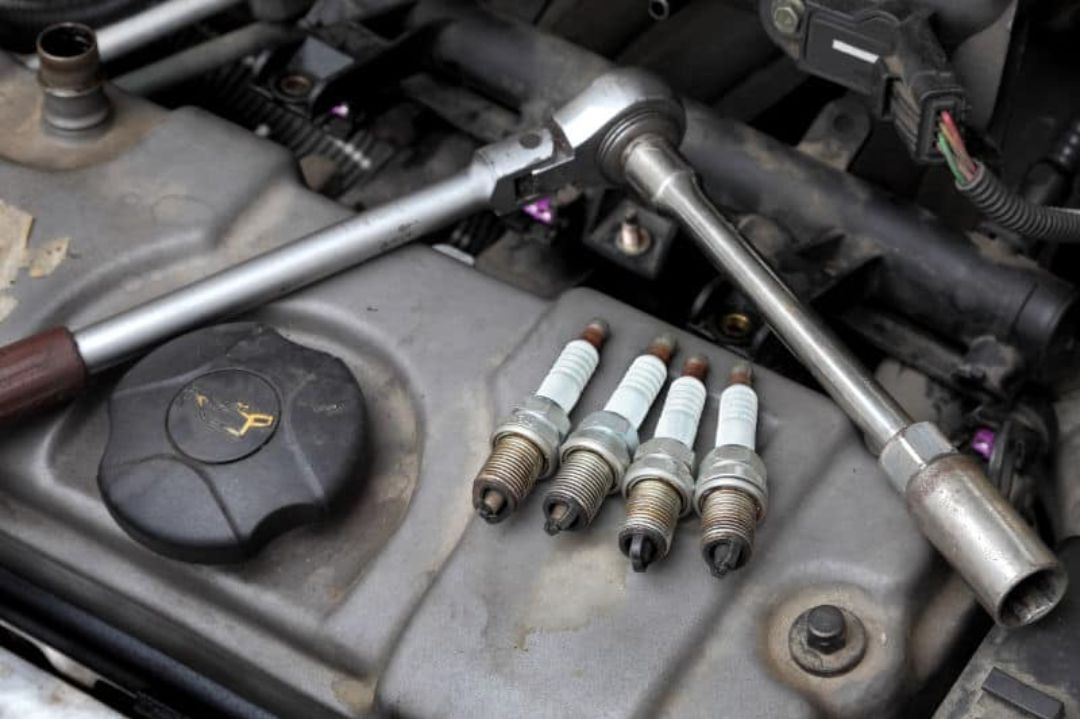If you’re in need of tightening your spark plugs but don’t have a torque wrench handy, fear not! We’ve got you covered with a step-by-step guide on How To Tighten Spark Plugs Without A Torque Wrench?
With just a few tools and a little bit of know-how, you’ll be able to ensure your spark plugs are tightened properly and ready to go.
In this article, we’ll walk you through the process, from gathering the necessary tools to reconnecting the battery and testing the spark plugs. You’ll learn how to:
- Prepare the engine
- Remove the old spark plugs
- Clean the spark plug threads
- Apply anti-seize lubricant
- Install the new spark plugs
So let’s dive in and get your spark plugs tightened up without the need for a torque wrench!
1. Gather the Necessary Tools

Now, you’ll need to gather all the tools you’ll need to tighten those stubborn spark plugs without a torque wrench.
Common mistakes to avoid when tightening spark plugs include overtightening or under tightening. To prevent these errors, it’s crucial to have the right tools at hand.
Firstly, make sure you have a spark plug socket that fits the size of your plugs. This specialized socket has a rubber insert that securely holds the spark plug while you tighten it.
Secondly, a ratchet or a breaker bar is essential for applying the necessary force. These tools allow you to easily turn the socket and tighten the spark plug.
Finally, invest in a torque wrench adapter. This handy tool attaches to your ratchet or breaker bar and provides a visual indication when you’ve reached the correct torque.
Following these tips for maintaining spark plug performance will ensure you tighten them properly every time.
2. Prepare the Engine
To prepare the engine for spark plug tightening without a torque wrench, there are two key points to keep in mind.
First, allow the engine to cool down completely before starting any work. This will prevent any potential burns or injuries.
Second, disconnect the battery to ensure safety and to avoid any accidental electrical shocks.
Follow these steps to ensure a smooth and safe process.
3. Allow the Engine to Cool Down
After the engine cools down, you can proceed with tightening the spark plugs without a torque wrench. However, before doing so, it’s important to take certain precautions.
Proper spark plug tightening ensures a secure seal, preventing any leakage or misfires. Begin by locating the spark plugs on your engine.
Use a spark plug socket and a ratchet to loosen the plugs in a counterclockwise direction. Once they’re loose, remove them carefully by hand.
Inspect the plugs for any signs of damage, such as cracks or wear, and replace them if necessary. To tighten the new plugs, insert them into the socket and carefully hand tighten them in a clockwise direction.
Be sure not to overtighten, as this can cause damage. Once tightened, give them a final check to ensure they’re secure.
4. Disconnect the Battery
Before you can proceed with the next step, there’s one important precaution you need to take – disconnect the battery. This step is crucial to ensure your safety and prevent any electrical mishaps.
Cleaning spark plug terminals is essential before tightening them, as any dirt or debris can affect the connection and lead to poor performance. Use a soft brush or compressed air to gently remove any grime.
When tightening spark plugs without a torque wrench, it’s important to be mindful of using the correct torque. Over-tightening can damage the threads, while under-tightening can result in loose connections and misfires.
To achieve the optimal torque, tighten the spark plugs snugly by hand and then use a spark plug socket and ratchet to give it a final quarter-turn.
Remember, using the correct torque is crucial for ensuring a proper seal and optimum performance of your spark plugs.
5. Remove the Old Spark Plugs
First, you’ll need to carefully extract the old spark plugs from the engine. To begin, make sure the engine is cool before proceeding.
Start by locating the spark plug wires and gently remove them by pulling straight up.
Next, use a spark plug socket and ratchet to loosen and remove the old spark plugs. Take note of any residue left on the spark plug threads as this could indicate potential issues with the engine.
Inspect the spark plugs for signs of wear or damage, such as worn electrodes or excessive carbon buildup. If you notice any problems, it may be necessary to troubleshoot further before installing new spark plugs.
Once the old spark plugs have been removed, proceed to the next step in the spark plug replacement process.
6. Clean the Spark Plug Threads
To ensure proper installation, it’s essential to thoroughly clean the threads of the spark plugs. Cleaning the spark plug threads is an important step in maintaining a secure and effective connection.
When the threads are dirty or corroded, it can lead to improper torque and potential damage to the spark plug or engine. Start by removing any dirt or debris around the spark plug hole using compressed air or a brush.
Then, use a thread chaser or a spark plug cleaning tool to clean the threads. Make sure to apply a small amount of anti-seize lubricant to the threads before reinserting the spark plug. This will help prevent future corrosion and make it easier to remove the spark plug in the future.
Remember, proper torque is crucial for optimal performance and longevity of your spark plugs, so always consult your vehicle’s manual for the recommended torque specifications.
7. Apply Anti-Seize Lubricant
Applying a small amount of anti-seize lubricant to the spark plug threads ensures future corrosion prevention and facilitates easier removal when necessary. This step is crucial, especially if you’re not using a torque wrench to tighten the spark plugs.
The anti-seize lubricant acts as a protective barrier, preventing rust and corrosion from forming on the threads. It also reduces friction during installation, making it easier to tighten the spark plugs by hand.
When using alternative methods to tighten spark plugs, such as a socket wrench or a spark plug socket, the anti-seize lubricant helps to ensure that the plugs are tightened to the correct specification.
Remember to apply the lubricant sparingly, as excessive amounts can cause the spark plug to seize or affect its heat dissipation properties.
8. Install the New Spark Plugs

To install the new spark plugs, first, insert the new spark plug into the socket wrench or spark plug socket. Make sure it’s securely held in place.
Then, carefully thread the new spark plug into the engine by hand, ensuring it’s properly aligned and tightened. Remember to be cautious and precise during this process to avoid any damage to the spark plug or engine.
Insert the New Spark Plug Into the Socket Wrench or Spark Plug Socket
Gently slide the new spark plug into the socket wrench or spark plug socket, ensuring a secure fit. It’s important to choose the correct spark plug socket size to ensure a proper fit and avoid damaging the spark plug.
Common spark plug problems, such as misfires or difficulty starting the engine, can occur if the spark plug is not securely installed.
Insert the spark plug into the socket with the threads facing outward and slowly twist it clockwise until it’s snug. Be careful not to overtighten the spark plug, as this can lead to stripped threads or a cracked porcelain insulator.
Use your hand or a ratchet wrench to tighten the spark plug until it’s firmly seated, but avoid using excessive force.
Carefully Thread the New Spark Plug Into the Engine by Hand
Now that you’ve inserted the new spark plug into the socket wrench or spark plug socket, it’s time to carefully thread it into the engine by hand. This step is crucial for proper spark plug maintenance and to avoid common spark plug problems.
Follow these steps to ensure a secure fit:
- Start by positioning the spark plug near the engine’s spark plug hole
- Slowly rotate the spark plug in a clockwise direction, making sure the threads engage smoothly.
- Continue threading the spark plug until it’s snug, but be careful not to overtighten it as this can lead to damage.
Remember, proper threading is essential as it ensures a good seal and prevents any leaks or misfires.
9. Tighten the Spark Plugs
First, grab the spark plug socket and attach it to the ratchet handle. Make sure the socket’s size is correct for your spark plugs. Insert the socket onto the spark plug and turn it counterclockwise to loosen and remove the old spark plug.
Once the old spark plug is removed, inspect it for any signs of damage or wear. Next, take the new spark plug and carefully thread it into the engine by hand.
Be cautious not to cross-thread it. Once the spark plug is hand-tightened, use the ratchet handle to further tighten it.
Apply gentle pressure to avoid over-tightening, as this can damage the threads or cause the spark plug to break.
Tighten the spark plug until it is snug, but be careful not to overtighten. This step is crucial for proper spark plug maintenance and replacement.
Watch Video: How To Tighten Spark Plugs Without A Torque Wrench?
10. Reconnect the Battery and Test the Spark Plugs
Once you’ve securely reattached the battery, it’s time to put those spark plugs to the test and see if your hard work paid off. Before proceeding, make sure you follow battery safety guidelines to avoid any potential hazards.
Start by turning the ignition key to the ‘On’ position without starting the engine. This’ll activate the electrical system and let you check for any signs of trouble. Listen for any abnormal sounds or misfiring that could indicate spark plug issues.
If everything sounds normal, proceed to start the engine and carefully listen for any rough idling or hesitation.
Also, observe the exhaust for any excessive smoke or unusual smells. If you notice any of these issues, it may be necessary to troubleshoot the spark plugs further to ensure proper tightening and functionality.
Frequently Asked Questions
Can I Tighten Spark Plugs without Using a Torque Wrench?
When tightening spark plugs without a torque wrench, alternative methods include using a spark plug socket and a ratchet, or simply using a socket wrench.
However, using a torque wrench ensures precise and consistent tightening, reducing the risk of damaging the spark plugs or the engine.
How Do I Determine the Correct Amount of Torque to Apply when Tightening Spark Plugs?
To determine the correct amount of torque when tightening spark plugs, use a torque wrench.
Proper torque is essential for optimal performance and to avoid damaging the engine.
Is It Necessary to Clean the Spark Plug Threads Before Installing New Spark Plugs?
You should clean the spark plug threads before installing new spark plugs. Not cleaning them can lead to improper seating, causing misfires and loss of power.
Using thread sealant is not necessary and can actually damage the spark plug.
What Type of Anti-Seize Lubricant Should I Use on Spark Plug Threads?
The best lubricant to use on spark plug threads is an anti-seize lubricant specifically designed for high-temperature applications.
It helps prevent seizing and allows for easier removal. Alternatives like grease or oil are not recommended due to their low heat resistance.
How Do I Properly Reconnect the Battery and Test the Spark Plugs After Installation?
To properly reconnect the battery and test the spark plugs after installation, first ensure the battery is securely connected.
Then, start the engine and listen for any abnormal sounds. Finally, use a spark plug tester to check for proper spark.
Conclusion: How To Tighten Spark Plugs Without A Torque Wrench?
You can tighten spark plugs without a torque wrench with the right tools and technique.
By following the steps outlined in this article, you can ensure a secure and properly functioning spark plug installation.
Remember to clean the threads and apply anti-seize lubricant for optimal performance. Take the time to tighten the spark plugs correctly to avoid any potential issues.
Finally, reconnect the battery and test the spark plugs to make sure they’re working effectively.




